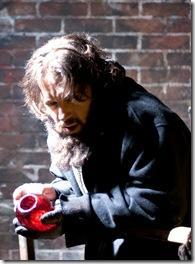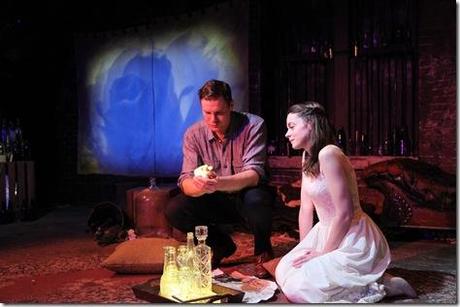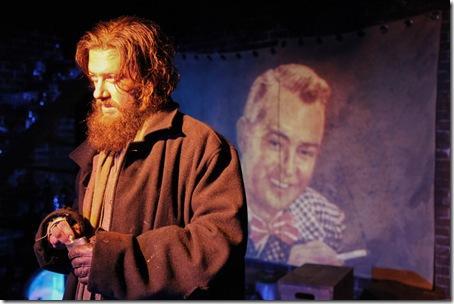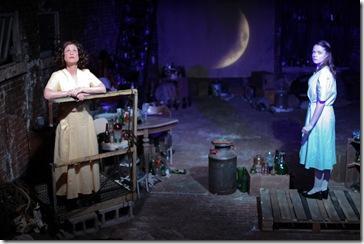
The Glass Menagerie
Written by Tennessee Williams
Directed by Hans Fleischmann
Angel Island Theatre, 735 W. Sheridan (map)
thru Jan 20 | tickets: $15-$25 | more info
Mary-Arrchie not afraid to break the glass

Mary-Arrchie Theatre Company presents
The Glass Menagerie
Review by John Olson
Given the similarity of this play’s characters to the real Tennessee (born Thomas) Williams and his immediate family, The Glass Menagerie is widely read to be autobiographical. When the play’s Tom Wingfield, an aspiring writer, finally leaves the home of his suffocating mother and emotionally/physically crippled sister, the audience’s tendency is to infer that Tom Wingfield ultimately did as well as Tom (Tennessee Williams), though the text of the play itself leaves the characters’ ultimate fates unresolved. For Mary-Arrchie’s production, director Hans Fleischmann has taken the bold move of suggesting that maybe Tom Wingfield’s destiny was just the opposite

Fleischmann doesn’t fool with the text itself, but he plays Tom as an angry, almost raging man in the scenes with mother Amanda and sister Laura. In fact, as much as one could say Fleischmann brings new insight into Tom, he brings new insight into homeless people as well – showing how one person dealing with homelessness once had a family and home – however dysfunctional – and the circumstances that led to his current impoverished situation. Fleischmann stays in his homeless attire throughout the play, and with Grant Sabin’s set resembling a back alley with just a few pieces of furniture representing the Wingfields’ apartment; we’re never allowed to leave this concept for a more literal depiction of Tom’s memories in depression-era St. Louis. Through most of the first act, the characters never face each other, but deliver their lines directly to the audience, as if Tom is remembering Amanda and Laura individually rather than as parts of a whole. This device makes The Glass Menagerie’s 20th Century realism rather presentational – and before long, it gets distracting. Fleischmann eases out of these direct addresses to the audience near the end of the first act, and in the second act – involving the visit from Tom’s co-worker Jim O’Connor – abandons them entirely. Is this because the text in Act Two demands significant physical interaction, or are Tom’s memories are coming together in clearer focus? Either way, this change is welcome.
The production also includes a series of projections which, perplexingly, are attempts at a comic counterpoint to the scenes. The absent head of the Wingfield family is projected as an illustration of a traditional dad from a ‘30s or ‘40s print ad. This might work as irony, but then the projections (designed by Anna Henson) use a series of anachronistic silent movie style titles that sometimes mock the emotions of the characters. Laura’s intense anxiety at seeing Jim – a boy she had much admired in high school who is the “gentleman caller” invited for dinner by Tom – is accompanied by a title reading “TERROR!” Other titles reinforce lines of dialog – frequently before they are delivered in the script, thus giving them away prematurely. The idea completely misfires – and the satirical nature of most of the titles may have led the opening night audience to laugh during much of the scene between Laura and Jim, Though it’s true enough that Williams had a keen eye for human frailty and self-delusion, the usual (and I think intended) reaction to this scene is empathy rather than laughs.
All that said, the production features really fine performances in all four roles. Maggie Cain’s Amanda is strong and toughened by the emotional and financial hardships of her current situation. Cain is funny where it’s intended and furious where the script calls for it. Joanne Dubach gives a truly fascinating performance as Laura – a quirky, mousy character who is so afraid of the world it seems she wants to be invisible. Dubach, in a completely unpretentious manner, makes her completely watchable and shows us the insides of this young woman who is trying to hide from the world. Walter Briggs is an appealing Jim – totally nailing the man’s insecurities and sadness even as he wants to be liked by all. Briggs brings the subtext of this character into focus and makes him as complex and fascinating as the three Wingfields. Their sensitive performances are complemented by a soft and melodic original musical score by Daniel Knox.
While Amanda, Laura and Jim are played as Tom would remember them (and the actors are accordingly dressed in 1930’s period costumes nicely designed by Stefan Steberl), Fleischmann clearly (and deliberately, I believe), plays Tom from the point of view of the older, homeless Tom of Fleischmann’s concept. He seems to be in the sort of rage we sometimes witness of such people on the street. In the flashback scenes, he has a ferocity that suggests the older Tom is resenting – perhaps even blaming – his mother for his misfortunes later in life. It’s a sharply different take on the character from the traditional interpretation and totally in keeping with his concept.
There’s a place for risk-taking in the service of a piece like The Glass Menagerie. It’s so frequently produced (due to its classic status and simple production demands of one small set and four actors) that we have many opportunities to see it performed traditionally. Fleischman asks us here, just this once, to look at the play from a different angle and learn something new about this classic. In spite of the production’s other excesses, Fleischmann’s concept and the fine acting of the cast make this production well worth a look.
Rating: ★★★
The Glass Menagerie continues through January 20th at Angel Island Theatre, 735 W. Sheridan (map), with performances Thursdays through Saturdays at 8 p.m., Sundays at 7 pm. Tickets are $15-$25, and are available by phone (773.871.0442) or online through TicketWeb.com (check for half-price tickets at Goldstar.com). More information at MaryArrchie.com. (Running time: 2 hours 10 minutes, includes an intermission)

Photos by Emily Schwartz and Fred Bledsoe Photography
artists
cast
Hans Fleischmann (Tom), Maggie Cain (Amanda), Joanne Dubach (Laura), Walter Briggs (Jim)
behind the scenes
Hans Fleischmann (director), Rudy Galvan (assistant director), Walter Briggs (technical director), Andrew C. Donnelly (stage manager), Grant Sabin (set design), Daniel Knox (original score, music director), Joe Court (sound design), Matthew Gawryk (lighting design), Stefin Steberl (costume design), Arianna Soloway (prop design), Mark Hackman (choreography), Anna Henson (projection design), Emily Schwartz, Fred Bledsoe Photography (photos)

12-1220

